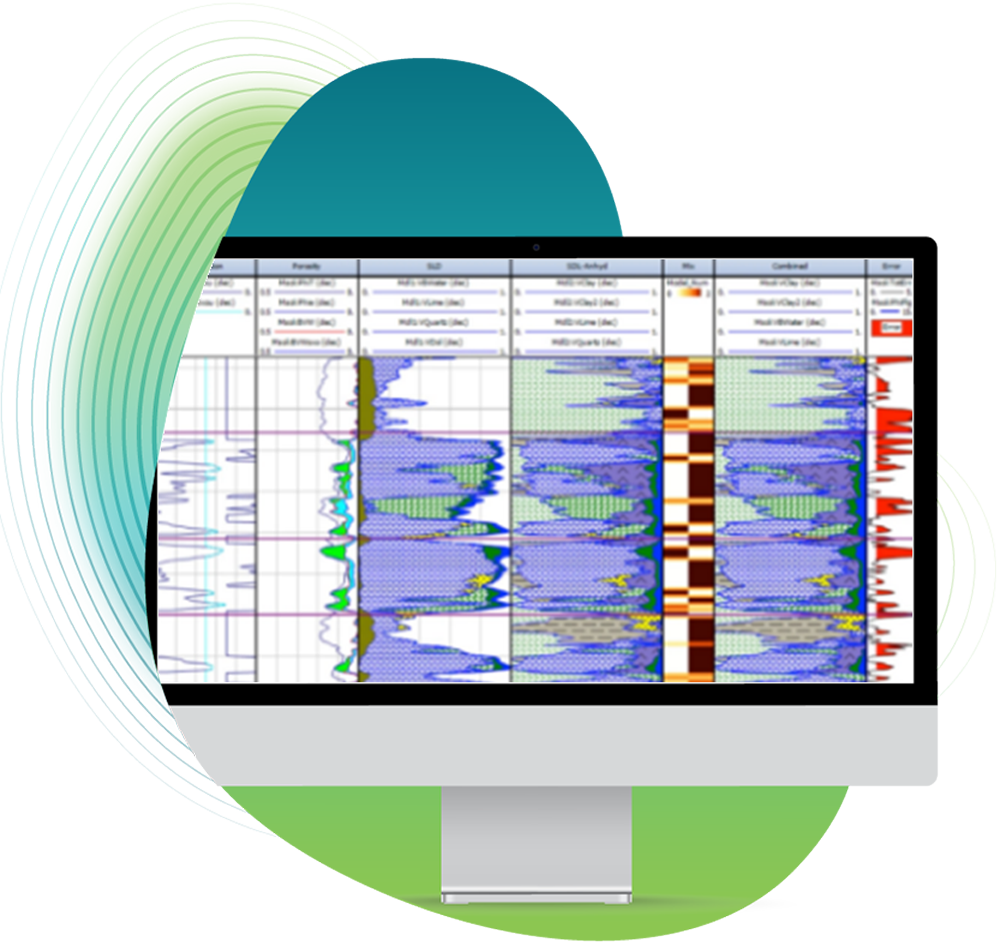Advanced Formation Evaluation
Advanced Formation Evaluation
Our IP Formation Evaluation range of modules offers robust and sophisticated petrophysical calculations for both deterministic and probabilistic analysis.
Fill in missing data. Pinpoint mineral composition. Classify facies, then apply Monte Carlo analysis to quantify your confidence in your interpretation.
This essential bundle provides a broad and in-depth toolbox for advanced formation evaluation of conventional and unconventional reservoirs.
Explore the modules
included in this toolkit

Paul Spooner
IP Product Champion
“Not only do you need software that you can trust, but it also needs to handle an incredible range of geology and data variability.
Anybody who knows me is aware that I’m likely to answer a how-to question with “it depends,” and that is why our workflows are so flexible, because they have to be”
Mineral Solver
Mineral Solver is the premier tool for non-deterministic assessment. Integrate all of your wellbore logs and core data into one solution for lithology, porosity and saturation.
- Handle carbonate wells with complex diagenetic histories, mixed-clay wells or even heavy-mineral effects in sandstones
- Understand unconventional reservoirs
- Include any mineral in your rock model to truly understand downhole lithology

Saturation Height Modeling
Analyse, quality control and correct capillary pressure data the easy way with Saturation Height. Apply industry-standard or your own custom fitting functions to quickly build a robust water saturation model from SCAL Pc data. Integrated workflow with other IP modules saves significant further effort.
- Reduce uncertainty in your petrophysical model
- Integrate multiple saturation height functions with our Function Mixing tool
- Apply functions to offset wells where no core Pc data is available
- Fit and apply functions per facies or per flow unit
- Link Free Water Level across multiple wells
Pictured: Visualise your saturation height functions in 2D or 3D to gain a better understanding of your model.

Formation Testing
Organise, display, analyse and interpret your pressure test data – all in a single module. Formation Testing works with all pressure test types made with different suppliers’ downhole tools to produce a comprehensive formation test report.
Generate and visualise graphical drawdown and build-up analyses. Estimate mobility and permeability. With Formation Testing's automated tools, you can process multiple pressure tests and summarise an entire well's results in minutes.
- QC pressure tests run by service companies
- Produce full-blown objective analysis and robust, easily-digested reports
- Build greater knowledge of your reservoir’s zones of interest
Pictured: Analyse the drawdown and build up of each formation pressure test and derive final formation pressures.

Hydraulic Flow Units
Classify reservoir rock into hydraulic flow grades with Hydraulic Flow Units (HFU). HFU bases its flow models on log and core data from single or multiple wells, relating permeability and porosity to production flow potential.
You can apply the HFU model as an input to IP’s statistical modules for nearby wells and define a continuous flow unit curve across the full data interval of the target well. Taking advantage of popular industry standards, HFU unlocks a powerful application for all core data across any field.
- Predict potential production value prior to well completion
- Identify zones with similar flow potential across multiple wells
- Refine static reservoir models and enhance saturation height calculation, helping better estimate hydrocarbon saturation
Pictured: Classify porosity and permeability data into distinct hydraulic flow units. Classification can be carried out using Winland R35, Pitmann, Rock Quality Index and Lucia Rock Class.

Sand/Silt Malay
Sand/Silt Malay is an advanced IP module for calculating petrophysical properties such as porosity, water saturation and lithology volumes but designed specifically for Silty Reservoirs as found in Malay Basin.
The model is designed for very fine grained sediments with fresh to brackish formation water. The model is based on a unique type of Neutron Density crossplot where a Quartz, Silt and Dry clay point are defined. It was built to overcome interpretation problems of standard shaley sand log analysis where an overestimate of clay volume leads to too pessimistic porosities.

Explore IP
From porosity and pore pressure to reservoir productivity, IP gives you an incredibly capable and customizable solution to share and interpret well logs and many other vital data types.
Toolkits
IP Foundation
Contains all the tools and modules required for the complete management of subsurface log data including loading, log plots, x-plots, histograms, editing, filtering, depth shifting, exporting etc. Carry out the full, deterministic, petrophysical workflow – Includes Clay Volume, Porosity/Water Saturation, Cut-Off and Summations modules plus NMR Interpretation. Also includes Monte Carlo Analysis for uncertainty analysis, Chrono Log, IP Power Tools and the ability to create you own IP applications.

Advanced Formation Evaluation
Carry out complex interpretations with Mineral Solver, and characterize your reservoir with Saturation Height Modeling, Hydraulic Flow Units, and Formation Testing modules.
Learn More
Borehole Imaging
Perform enhancements and corrections to Image Log data, utilize the vast amount of display and interpretation options specifically tailored for all the main image log tool types on the market.
Learn More
Cased Hole
Assess the downhole integrity of your wells with the casing and cement evaluation modules, while also monitoring reservoir fluid saturations and the production performance of each well.

Geomechanics
Assure your well’s stability and maximize production lifetime using our suite of Geomechanics modules. Calculate pore pressures, determine wellbore stability and calculate risk of sand production.

Geophysics
Bring your Petrophysics and Geophysics teams together to calculate the downhole acoustic properties of the formation, carry out fluid substitution analysis and create synthetic seismograms.

Machine Learning
Carry out data repair, prediction of missing curves, or key reservoir properties using minimal source data. Classify reservoir rock types using Self Organizing Maps and Cluster Analysis.

North Sea Database
Our database is designed to streamline exploration efforts across the Norwegian North Sea. Providing DISKOS members this powerful tool will save you time and money, offering first-hand verified data that ensures accuracy and reliability.

